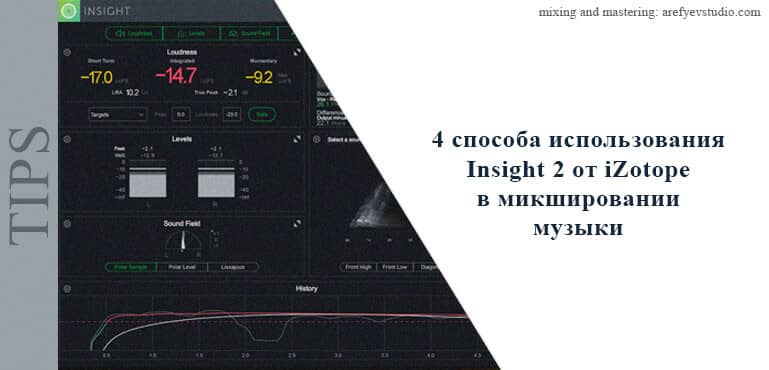For many, Insight 2 from iZotope remains a mysterious tool, and its functionality is often not fully disclosed. In this article, we will talk about a few of our tricks for using it.
1. Intelligent Vocal Presence Meter

The smart meter was designed primarily for post-production. However, it also works in the context of music. If we put a Relay instance in the last slot on the vocal / vocal bus, we can control the apparent integrity of the voice with respect to the rest of the material. By “integrity” we mean its readability and legibility.
This unit is very convenient because it is difficult to understand the intelligibility of vocals on various playback systems. The meter is tuned to a low noise environment and can help you make impartial decisions. All you have to do is keep track of the meter and the built-in beacons. If they are in a “sweet” place, then there is every reason to believe that the words will be legible in the track. If the slider flies higher or falls lower, you can correct the effects used placed before Insight 2.
— See also: 8 sets of plugins that cannot be ignored —
2. Using a spectrogram relay to balance the equalizer
During the time spent using Insight 2, the package shows itself flawlessly when it is paired with the Relay module. Relays can be tied to tracks, submixes, aux, or anywhere else. We simply highlighted its utility along with an intelligent meter, but you can also use it in combination with a spectrogram. The spectrogram goes beyond your typical frequency analyzer to show the equalizer of your mix over time and with a great visual representation. You can pinpoint what each element in the mix does by using the spectrogram in the shadow:
- the growing concentration in color from light to dark shows you how influential things are at a given frequency; the weaker the color cast at 200 Hz, the less pronounced the band.
All this is good, but the Relay module gives a shortcut to any single element so that you can trace the drums or even one drum in the context of the mix. By default, the entire mix is in shades of gray, but for elements assigned with Relay, colors are set that you can change as needed. You should always use your ears to make decisions, this is undeniable! But at the end of the work, when the ears get tired, you need to trust visual analyzers.
3. Penetrating Automation Using Relays

Automation can be complicated. It happens that they forgot about the included automation, moved the fader, and the levels returned to the set values. This can certainly happen if you have been different from the mix for a few days. Over the years, we have developed a workaround: we use level automation at the output of the last plug-in in the chain, unless this plug-in was an analog emulation, where the output changes the tonal characteristics. In this case, you can use free lightweight utilities for certain purposes (for example, GVST).
In order not to complicate the process of mixing the project, Insight 2 eliminated this workaround. If after processing the track is too low in level or if automation has already been applied, we do not need to grab it and move it. Also, no additional plugins are required to raise the level. Having Relay as the last track in the chain, we can do it there. Relay handles the basics of the utility, and also performs the above change tasks. Directly in it, you can correct the output level of the selected track.
— See also: 7 great plugins for mixing vocals —
4. Using easy-to-read volume meters throughout the mixing process
By default, Insight 2 has three different types of speakers: instant, short-term, and integrated. All three have their advantages when working with mixes, and thanks to the new interface in Insight 2 you can resize these meters so that they occupy only the corner of the screen, providing a constant but modest check. The difference in instant, short-term and integrated action is related to how much time the device uses to calculate readings. Instant is especially useful for tracking clips on vocals to make sure it is at a relatively even level. The short-term approach helps you keep track of how loud the mix is in the selected section. Mastering engineers often monitor this during the audio processing process. Integrated (combined) gives an idea of the overall volume of the entire work.
Yes, there are other aspects of Insight 2 for which we did not have time for in-depth study. We believe that the largest of them is presets for music production in the “Layout” section, which allows you to instantly change the layout of the graphical interface in accordance with a given mixing task. Another is Relay’s ability to re-align stereo signals and fix phasing problems in this way. But we think that these four samples are representative enough for the benefits that this measurement plugin gives you, not only for publishing, but also for producing stereo music. These counters, of course, made our life easier in a short time, saving a huge amount of resources.



